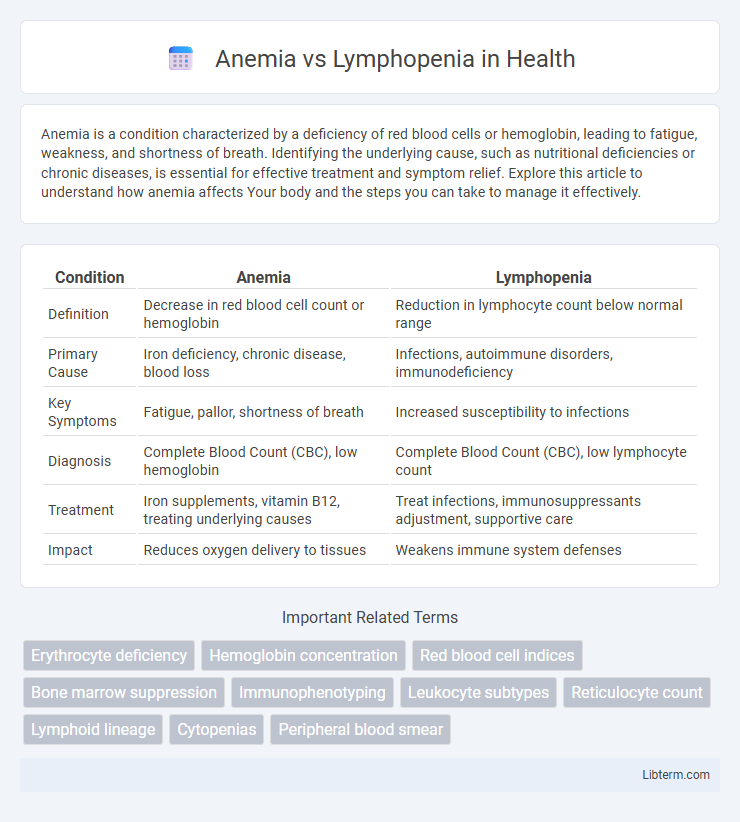Anemia is a condition characterized by a deficiency of red blood cells or hemoglobin, leading to fatigue, weakness, and shortness of breath. Identifying the underlying cause, such as nutritional deficiencies or chronic diseases, is essential for effective treatment and symptom relief. Explore this article to understand how anemia affects Your body and the steps you can take to manage it effectively.
Table of Comparison
| Condition | Anemia | Lymphopenia |
|---|---|---|
| Definition | Decrease in red blood cell count or hemoglobin | Reduction in lymphocyte count below normal range |
| Primary Cause | Iron deficiency, chronic disease, blood loss | Infections, autoimmune disorders, immunodeficiency |
| Key Symptoms | Fatigue, pallor, shortness of breath | Increased susceptibility to infections |
| Diagnosis | Complete Blood Count (CBC), low hemoglobin | Complete Blood Count (CBC), low lymphocyte count |
| Treatment | Iron supplements, vitamin B12, treating underlying causes | Treat infections, immunosuppressants adjustment, supportive care |
| Impact | Reduces oxygen delivery to tissues | Weakens immune system defenses |
Understanding Anemia: Definition and Causes
Anemia is a condition characterized by a deficiency in the number or quality of red blood cells or hemoglobin, leading to reduced oxygen transport in the body. Common causes include iron deficiency, chronic diseases, vitamin B12 or folate deficiency, and bone marrow disorders. Unlike lymphopenia, which involves low lymphocyte counts affecting immune function, anemia primarily impacts oxygen delivery and manifests through fatigue, pallor, and shortness of breath.
What is Lymphopenia? Overview and Key Factors
Lymphopenia is a medical condition characterized by an abnormally low level of lymphocytes in the blood, which are critical components of the immune system responsible for fighting infections. Key factors contributing to lymphopenia include autoimmune diseases, viral infections such as HIV, malnutrition, chemotherapy, and radiation therapy. This condition can lead to increased susceptibility to infections and may be detected through complete blood count (CBC) tests indicating lymphocyte counts below the normal range of 1,000 to 4,800 lymphocytes per microliter in adults.
Symptoms: Anemia vs Lymphopenia
Anemia symptoms include fatigue, pallor, shortness of breath, and dizziness due to reduced red blood cell count or hemoglobin levels. Lymphopenia symptoms often involve increased susceptibility to infections, as it reflects a deficiency in lymphocytes, key cells in the immune response. While anemia primarily affects oxygen transport, lymphopenia compromises immune defense, leading to distinct clinical presentations.
Underlying Causes and Risk Factors
Anemia primarily results from iron deficiency, chronic diseases, or bone marrow disorders, with risk factors including poor nutrition, blood loss, and certain chronic conditions like renal disease. Lymphopenia arises from viral infections, autoimmune diseases, malnutrition, or immunosuppressive treatments, with increased risk in patients undergoing chemotherapy or living with HIV/AIDS. Both conditions reflect underlying immune or hematologic dysfunctions that require targeted diagnostic evaluation to identify the specific etiology.
Diagnostic Approaches: Tests and Markers
Anemia diagnosis primarily involves a complete blood count (CBC) to measure hemoglobin, hematocrit, and red blood cell indices, alongside reticulocyte count to assess bone marrow response. Lymphopenia evaluation centers on lymphocyte count from CBC and flow cytometry to analyze lymphocyte subsets, which aids in identifying underlying causes like immunodeficiencies or infections. Additional markers for anemia include serum ferritin, vitamin B12, and folate levels, while lymphopenia investigations may incorporate viral serologies and autoimmune panels.
Common Complications Associated
Anemia commonly leads to fatigue, pallor, and increased cardiac workload, which can result in heart failure if untreated, while lymphopenia heightens susceptibility to infections due to impaired immune defense. Both conditions can cause weakened physical performance and delayed recovery from illnesses, with complications varying based on the severity and underlying causes. Monitoring blood counts and addressing root causes are critical to prevent serious complications like opportunistic infections in lymphopenia or severe hypoxia in anemia.
Treatment Options for Anemia and Lymphopenia
Treatment options for anemia depend on its cause and severity, including dietary supplementation with iron, vitamin B12, or folic acid for deficiency-related anemia, erythropoiesis-stimulating agents for chronic kidney disease anemia, and blood transfusions in severe cases. Lymphopenia treatment targets the underlying cause, such as discontinuing immunosuppressive drugs, managing infections, or addressing autoimmune disorders, with therapies including antiviral medications, corticosteroids, or immunoglobulin replacement in specific conditions. Monitoring blood counts and addressing nutritional deficiencies are essential components in managing both anemia and lymphopenia to restore normal hematologic function.
Prevention Strategies and Lifestyle Modifications
Effective prevention strategies for anemia include maintaining a diet rich in iron, vitamin B12, and folate, along with regular screening for individuals at risk such as pregnant women and those with chronic illnesses. For lymphopenia, lifestyle modifications emphasize managing underlying causes like infections or autoimmune disorders and bolstering immune health through adequate sleep, stress reduction, and balanced nutrition. Both conditions benefit from avoiding excessive alcohol consumption and smoking, which impair blood and immune system function.
When to Seek Medical Attention
Seek medical attention for anemia if you experience persistent fatigue, shortness of breath, paleness, or rapid heartbeat, as these symptoms indicate low red blood cell counts requiring diagnosis and treatment. In cases of lymphopenia, consult a healthcare professional if recurrent infections, unexplained fevers, or signs of immune system weakness occur, signaling potential underlying conditions or immune deficiencies. Timely medical evaluation and blood tests are essential to determine the cause and appropriate management for both anemia and lymphopenia.
Prognosis and Long-Term Outlook
Anemia often presents with a variable prognosis depending on its etiology, with iron-deficiency anemia typically resolving well under appropriate treatment, while chronic disease-related anemia may indicate ongoing health issues requiring long-term management. Lymphopenia, characterized by a decreased lymphocyte count, can signal underlying immunodeficiency or chronic conditions, and its prognosis is largely influenced by the severity and cause of immune suppression. Long-term outlook for anemia varies from full recovery to chronic complications, whereas persistent lymphopenia may lead to increased vulnerability to infections and requires close monitoring to prevent serious immunological consequences.
Anemia Infographic

 libterm.com
libterm.com